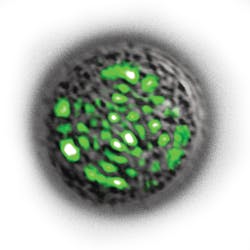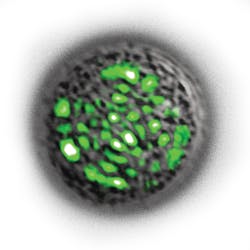CELL BIOLOGY/PROTEOMICS: First-ever single-cell biological laser excites imagination
By engineering human embryonic kidney (HEK) cells to produce green fluorescent protein (GFP), and by placing one such cell between two mirrors to make an optical cavity with a 20 µm diameter, two Boston-based scientists have succeeded in creating the first “bio laser.” When Seok-Hyun Yun, an optical physicist at Harvard Medical School and Massachusetts General Hospital and his colleague Malte Gather, shone pulses of blue light onto the cell, it emitted a directional laser beam visible with the naked eye. And the cell remained unharmed.1
Yun and Gather say the bio laser’s light generates a unique emission spectrum related to both the structure of the cell and the proteins inside it—so biologists could use the approach to study cells.
In addition, Yun thinks that lasers could one day be generated or amplified inside the body, where they could penetrate the relevant tissues more deeply. For this, the work needs refinement, however, including development that would allow the laser to work inside a living organism. Yun thinks that integrating a nanoscale optical cavity into the laser cell itself could achieve the goal. Technologies to make such cavities are emerging and could be used to create a cell that could “self-lase” from inside tissue, he says. Because external light is needed to stimulate the laser action, though, Michael Berns, a biomedical engineer at the University of California, Irvine, sees the approach as more useful for studying thin-tissue systems or cells in culture or suspension.
1. S. H. Yun and M. Gather, Nature Photonics, doi:10.1038/nphoton.2011.99 (2011).
More BioOptics World Current Issue Articles
More BioOptics World Archives Issue Articles

